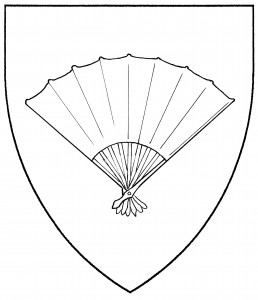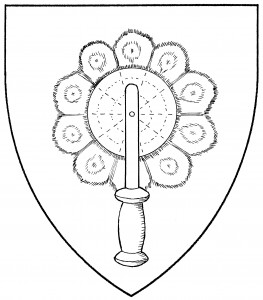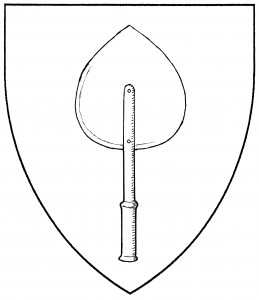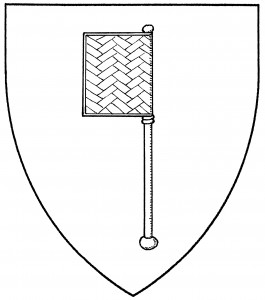A fan is a device for generating a current of air. In medieval heraldry, the default fan was more fully termed a “winnowing fan” or “vannet”; it was used to blow the chaff from grain. It’s a period charge, found in the canting arms of Septvans or Sevans, c.1275 [ANA2 556]; the handles are to chief, the wide part to base, by default.
In Society heraldry, the default fan is the handheld folding fan, used to cool humans. This form is open or spread, with the wide part to chief, by default. The folding fan is found in later period portraits (as in the “Ditchley” portrait of Elizabeth I, by Marcus Gheeraerts the Younger, c.1595), but no examples are known in European armory. However, a similar form, with paper covering the ribs, is found in Japanese Mon; this form (ogi) was borne by Satake Yoshinobu, 1569-1633 [Hawley 59].
Three other fans are found in Society armory. There’s the “feather fan”, with plumes attached to a handle; it’s similar to a feather-edged fan found in the arms of Hintaller, mid-16th C. [NW 56]. There’s also the “liturgical fan”, a solid piece of stiffened fabric, used in church to keep insects away from the Host [EB X:168]. Finally, we have the “flag fan” (ventuolo) of 16th C. Italy, a stiff vane of woven fiber or parchment on an offset handle, as seen in Boissard’s Habitus Variorum Orbis Gentium, 1581.
All of these fans are palewse, with handles to base, by default. Additionally, the asymmetrical flag fan has its vane to dexter by default; it is granted no difference from a banner (cf. flag).
See also basket.
Bronwyn Morgana MacPherson bears: Per bend azure and Or, a fan and a whelk shell counterchanged.
Emrys FitzRainold de Venoix bears: Per fess rayonny azure and gules, three vanneaux Or.
Christiana Haberdasher bears: Gules, a feather fan argent handled Or.
Regina from Adiantum bears: Ermine, three liturgical fans gules.
Aurora Lucia Marinella bears: Per pale gules and azure, in pale a flag fan fesswise flag to chief and a cushion Or.




